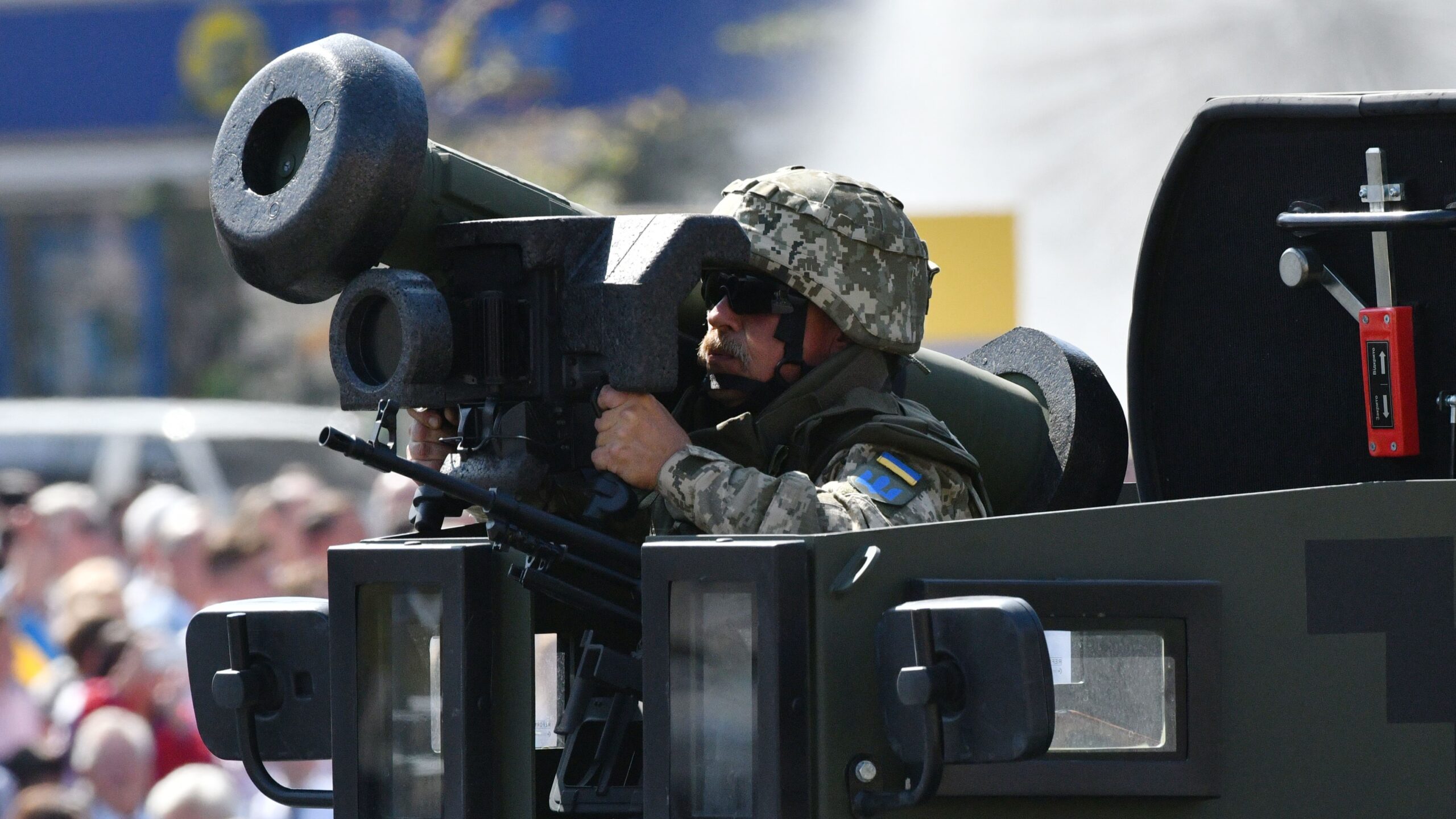
A Ukrainian serviceman rides atop of an APC with Javelin anti-tank missiles during a military parade in Kiev on August 24, 2018. The weapons will be a key part in Ukraine’s defense against a Russian invasion. (Genya Savilov/AFP via Getty Images)
With multiple media reports saying Russia plans to invade Ukraine in the next 48 hours, the chances of avoiding a major conflict between Moscow and Kyiv seem slim. If Russia does start a conflict, it will pit two modernized militaries against each other, with very different tactics: Russia’s traditional military might against more of an insurgent Ukraine. In doing so the conflict, along with incurring with very real human costs, could provide real-world answers for the many questions facing America’s military as it seeks to modernize for the future, writes Mark Cancian of CSIS.
A war between two highly developed nation-states like Russia and Ukraine offers the rare opportunity to see how modern weapons work, and more importantly, how they interact in an action/counteraction that is impossible to simulate in peacetime. Are tanks obsolete? Is cyber a game-changer? Unfortunately, with such a war seemingly imminent, military analysts may get a chance to make such assessments based on battlefield experience rather than peacetime exercises and analysis.
To be clear: no one wants to see war between Russia and Ukraine, one the Chairman of the Joint Chiefs has predicted will be “horrific” for civilians, to happen. There is still a hope such a conflict can be avoided. But if it is happening, it is incumbent upon us to learn what we can. Here, then, are five dynamics to watch.
RELATED: Read Breaking Defense’s coverage of the Ukraine situation here
1. Are tanks still viable on the modern battlefield? Analysts have been predicting the end of tanks since the introduction of long-range precision antitank missiles in the early 1970s. Yet, tanks maintained their battlefield primacy in the Arab-Israeli war of 1973, the Iran-Iraq war of 1980 -1988, and the US wars in Iraq (1991, 2003). Over time, however, these antitank weapons have become longer-range and smarter. For example, the Javelin antitank missile that the United States has provided to Ukraine has a 4,000-meter range and fire and forget guidance, which allows operators to hide from adversaries. The high-capacity warhead and top attack make the system highly lethal.
Inside the US military, there is no clear agreement on tanks. The US Army continues to buy tanks at the rate of about 100 per year and has fielded one additional armored brigade combat team in the last few years. It maintains an armored brigade combat team in Eastern Europe on a rotational basis to reassure and defend the eastern European NATO allies. The Army believes in tanks.
The Marine Corps does not believe in tanks. It dumped all of them last year and deems its antitank weapons capable of handling any armored threats it might face. It regards the results of the Nagorno-Karabakh War of 2020 as evidence that drones dominate tanks.
So, who is right? The Russians field a large tank force and will use it in any conflict with Ukraine; while the Ukrainians have armor, it is largely outdated and they are expected to rely heavily on antitank weapons, including American-provided Javelins. The success or failure of that tank force will give insights into how the United States should structure its tank and antitank forces in the future.
2. Is cyber really a game-changer? Many digital proponents argue that cyber has the potential to cripple, if not outright defeat, adversaries before forces even engage. They point to past attacks on operating systems, weapons guidance, communications, geolocation, and web operations. They look for a “cyber Pearl Harbor” that cripples an adversary at the start of the conflict. The recent book, 2034: a Novel of the Next World War by retired Adm. James Stavridis and Elliot Ackerman, envisions Chinese cyber capabilities crippling the US Pacific Fleet and allowing its destruction.
On the other hand, there are analysts who argue that cyber is overrated and unproven, without major operational results to date. They point out that if cyber has not shown a decisive capability by now, the capability probably does not exist. After all, the events that proponents point to as “cyber Pearl Harbors” produced minor effects, like shutting down some websites for a short time or making some local operations difficult, hardly the sinking of eight battleships, destruction of 300 aircraft, and killing of over 2,400 Americans implied by the name.
The problem with cyber operations is that the capabilities are hard to truly judge because of the secrecy. Many tools rely on adversary vulnerabilities discovered ahead of time. Exploiting these vulnerabilities are generally single-use opportunities because once a power uses them, its adversaries will quickly develop countermeasures. Thus, it’s unclear whether countries like Russia are holding some powerful weapon and just waiting for the right moment for a devastating but one-time use, or whether such powerful weapons simply do not exist. The answer will shape US cyber operations and determine whether they are a primary or supporting effort in future conflicts and whether US military operations, which rely on network conductivity, are safe.
3. Are helicopter operations viable when the adversary has even decent air defenses? Helicopters are integral to the operations of US military forces, with a total US inventory of about 4,500. The Army is particularly invested in helicopters, with about 3,100 conducting a wide variety of transportation and attack functions. There is even an air assault division, the 101st.
During the Vietnam War, the Army perfected airmobile tactics whereby helicopters would insert troops deep inside an adversary’s terrain, making a lodgment before the adversary could react. Attack helicopters provided mobile fire support for ground forces.
However, helicopters are extremely vulnerable since they fly low and slow. In Vietnam, the United States lost 5,600 helicopters. During the Russian war in Afghanistan, the United States supplied anti-aircraft Stinger missiles to the mujahedin opposition. These wreaked havoc on Russian helicopters, limiting their operations. In the 2003 US invasion of Iraq, the one heliborne operation ran into serious problems because of ground fire.
The Russians have a lot of helicopters and the doctrine to use them. Ukrainians have a limited but nevertheless effective anti-helicopter capability. The Russians may try to insert special forces or even infantry formations deep inside Ukraine to disrupt operations and perhaps hit key targets. Will this be successful, or will anti-aircraft weapons exact such a toll that such operations become infeasible? And if Russia can’t handle the fairly limited Ukrainian air defense options, what does it say about the use of rotorcraft against a great power armed with more advanced capabilities? The answer will indicate whether the US heavy investment in helicopters is warranted.
4. Is it still possible to launch an amphibious assault on a hostile shore? Amphibious assaults arguably won World War II for the Western allies. Landings in North Africa (Nov. 1942), Sicily (July 1943), Salerno (Sept. 1943), and Normandy (June 1944) allowed the Western allies to come to grips with the German and Italian forces. In the Pacific, the Marine landings on Guadalcanal, Tarawa, Iwo Jima, and Okinawa became the stuff of legends. The Army had its own series of major amphibious operations in the Pacific.
Yet, after the war, Gen. Omar Bradley declared that such operations were impractical because of nuclear weapons. The Marines didn’t get the memo, and just a year later, launched their epic landing at Inchon, flanking and ultimately destroying the North Korean army that had invaded South Korea.
In the modern era, the Marines never faced a truly opposed landing, but the British did. In May 1982 the British landed on the Falkland Islands to drive out the Argentinian forces that had seized the islands the month before. The assault was a success, though with high casualties among the ships.
RELATED: The Russian military build up near Ukraine is happening at sea too
The Russians are now threatening the Ukrainian coast with a landing force embarked on amphibious ships. If they can land and seize territory, that would argue that amphibious assaults are still possible. That success or failure means a lot for the Marine Corps as it thinks about the future of its central mission.
5. Has the artillery come to dominate the modern battlefield? The French in World War I used to say: the artillery conquers, the infantry occupies. World War II seemed to give tanks and aircraft a more prominent role. Subsequent wars, particularly in the Middle East, continued to give armor and airpower the major role, while insurgencies focused on infantry. Artillery always had a role, but a supporting one.
Modern artillery has two capabilities unavailable before: precision, long-range munitions that can hit targets exactly, and sensors like UAVs that can find targets with greater facility. This “reconnaissance/strike capability” has opened tantalizing possibilities. In the 2014 conflict between Ukraine and Russia, a Russian artillery missile strike reportedly annihilated two Ukrainian battalions.
If such capabilities are dominant on the modern battlefield, the emphasis in US forces should shift from the infantry and armor to the artillery.
The need for caution: Predicting the future of warfare between major powers by looking at the experience of conflicts with smaller powers is a tricky business. A US-Russia or US-China conflict might look very different from a Russia-Ukraine conflict. A lesson in humility comes from the Spanish Civil War of 1936-1939. Although it was a Civil War, the Germans and Italians supported the nationalists while the Soviet Union supported the Republicans. Many saw the conflict as a forerunner of the Second World War. However, the Spanish Civil War seemed to indicate that future conflicts would be primarily infantry affairs, with tanks and airpower providing useful but supporting roles. The experience in World War II was quite different.
Nevertheless, the shortage of crystal balls being what it is, a Russia-Ukraine war will provide the best insight available into the dynamics of the future battlefield. Military analysts will mine it for lessons to be learned and shape US forces and doctrine as a result.
Mark Cancian, a member of the Breaking Defense Board of Contributors, is a retired Marine colonel now with the Center for Strategic and International Studies.






















